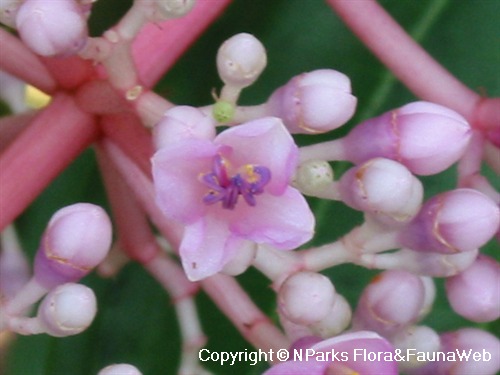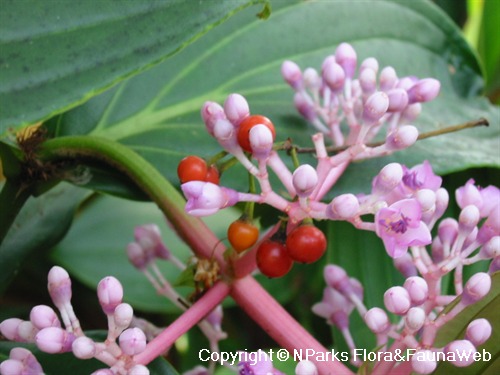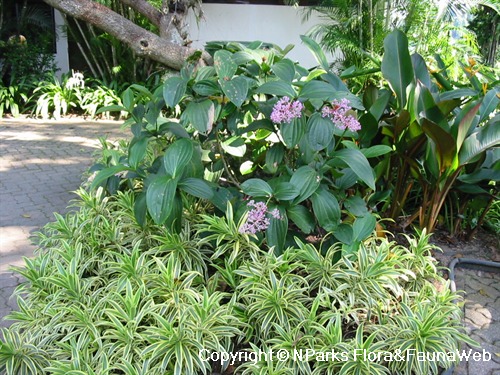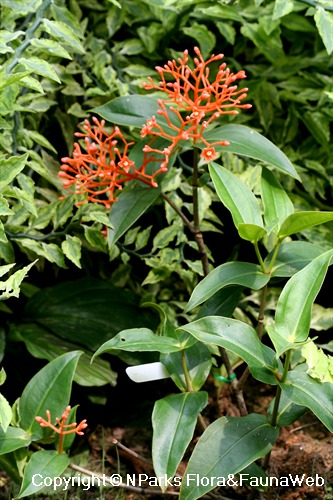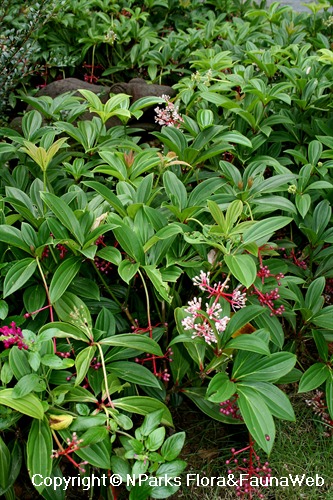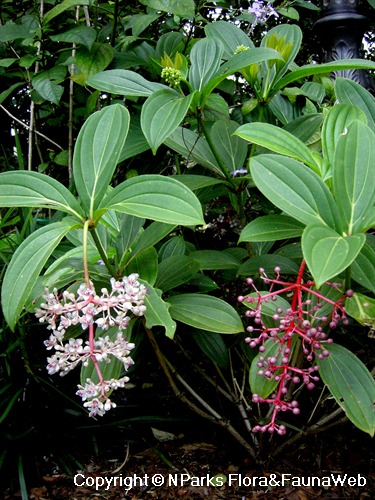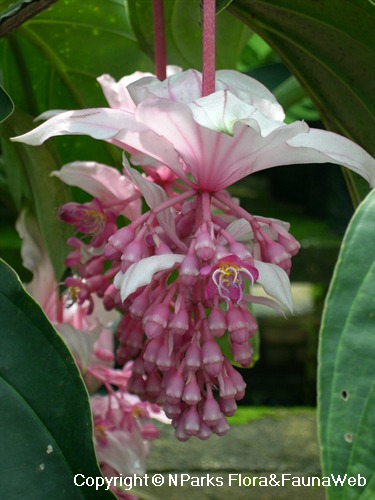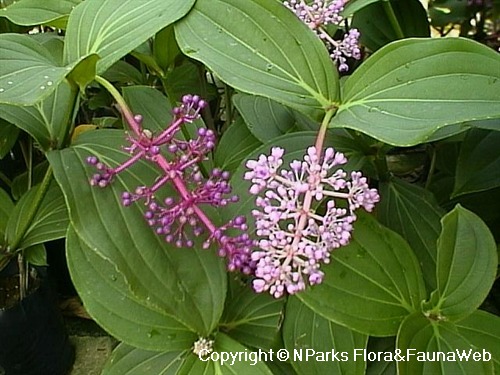
Name
Classifications and Characteristics
| Plant Division | Angiosperms (Flowering Seed Plants) (Dicotyledon) |
|---|---|
| Plant Growth Form | Epiphyte, Herbaceous Plant |
| Lifespan (in Singapore) | Perennial |
| Mode of Nutrition | Autotrophic |
| Plant Shape | Shrubby |
| Maximum Height | 1.2 m to 1.8 m |
| Maximum Plant Spread / Crown Width | 1.2 m to 1.8 m |
Biogeography
| Native Distribution | Philippines |
|---|---|
| Native Habitat | Terrestrial (Primary Rainforest, Secondary Rainforest) |
| Preferred Climate Zone | Tropical |
Description and Ethnobotany
| Growth Form | Herbaceous shrub, semi-epiphytic and growing on trees in the wild, but usually cultivated on ground or in containers, up to 1.8m height if planted into ground. |
|---|---|
| Foliage | Leaves large, leathery, somewhat glossy, with 7 prominently-sunken veins, oppositely arranged around stems. |
| Flowers | Small, 4 light pink petals with purplish stamens, produced in pendulous panicles. |
| Fruit | Fruits are fleshy globose berries, ripen from light pink to magenta to red over several weeks. |
| Habitat | Endemic to primary forest ravines in Philippines |
| Similar | Similar-looking to Medinilla cumingii, whose leaves are narrower, with 5 veins and whorled arrangement around stems. |
| Cultivation | Prefers bright shade and moist soils. Propagate by cuttings of older stems. Also easily propagated by seeds -- allow fruits to get very ripe on plant, before harvesting them for seeds. |
| Etymology | Genus epithet 'Medinilla' is named after José de Medinilla of Pineda, mid-19th century governor of Marianna Islands in northwestern Pacific Ocean. |
Landscaping Features
| Desirable Plant Features | Ornamental Foliage, Ornamental Flowers, Ornamental Fruits |
|---|---|
| Landscape Uses | Suitable for Hanging Baskets, Interiorscape/ Indoor Plant, General, Container Planting |
| Thematic Landscaping | Naturalistic Garden |
Fauna, Pollination and Dispersal
| Pollination Method(s) | Biotic (Fauna) (Insects (Ant, Beetle, Fly, Thrip, Wasp)) |
|---|
Plant Care and Propagation
| Light Preference | Semi-Shade |
|---|---|
| Water Preference | Lots of Water |
| Plant Growth Rate | Moderate |
| Rootzone Tolerance | Fertile Loamy Soils, Well-Drained Soils |
| Maintenance Requirements | Moderate |
| Propagation Method | Seed, Stem Cutting |
| Propagation Method Remarks | Take cuttings from older stems. Allow fruits to get very ripe on plant. before collecting seeds. |
Foliar
| Foliage Retention | Evergreen |
|---|---|
| Mature Foliage Colour(s) | Green |
| Mature Foliage Texture(s) | Smooth, Raised / Sunken Veins, Thick |
| Prominent Young Flush Colour(s) | Red |
| Foliar Type | Simple / Unifoliate |
| Foliar Arrangement Along Stem | Opposite |
| Foliar Shape(s) | Non-Palm Foliage (Elliptical) |
| Foliar Venation | Parallel |
| Foliar Margin | Entire |
| Foliar Apex - Tip | Cuspidate |
| Foliar Base | Rounded / Obtuse |
| Typical Foliar Area | Mesophyll ( 45cm2 - 182.25 cm2 ) |
| Leaf Area Index (LAI) for Green Plot Ratio | 4.5 (Shrub & Groundcover - Dicot) |
Non - Foliar and Storage
| Stem Type & Modification | Herbaceous |
|---|---|
| Root Type | Underground (Fibrous Root) |
Floral (Angiosperm)
| Flower & Plant Sexuality | Bisexual Flowers |
| Flower Colour(s) | Pink |
|---|---|
| Flower Symmetry | Radial |
| Inflorescence Type | Panicle |
| Flowering Period | Free-Flowering |
| Flower Lifespan on Plant | Several Days |
| Flowering Habit | Polycarpic |
Fruit, Seed and Spore
| Mature Fruit Colour(s) | Red |
|---|---|
| Fruit Classification | Simple Fruit |
| Fruit Type | Fleshy Fruit |
Image Repository
Others
| Master ID | 14009 |
|---|---|
| Species ID | 3326 |
| Flora Disclaimer | The information in this website has been compiled from reliable sources, such as reference works on medicinal plants. It is not a substitute for medical advice or treatment and NParks does not purport to provide any medical advice. Readers should always consult his/her physician before using or consuming a plant for medicinal purposes. |

